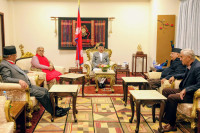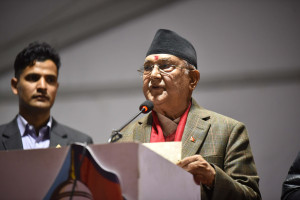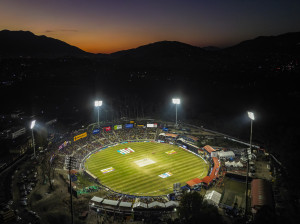Editorial
Where’s hope?
We don’t need the IMF to remind us of the financial hole in which the country now finds itself.
Successive downward revisions of Nepal’s annual growth forecast suggests the economy continues to battle strong headwinds. This year’s annual budget had foreseen eight percent growth, which had to be pegged back to 4.5 percent during the mid-term budget review. Now, the International Monetary Fund (IMF) says the country will grow at only 4.4 percent this fiscal year—significantly lower than the 5.8 percent growth achieved in the last fiscal year. Nepali banks still face a severe liquidity crisis and there is no money in the market. In a Feb 28 statement, the IMF noted how “Nepal’s real GDP growth is supported by the ongoing recovery of tourism, strong agriculture sector performance in the first half of the year and resilient remittances.” But then it pointed out the country’s vulnerability to “…shocks, from volatile and higher global commodity prices and from natural disasters and weather variability.” The import restrictions Nepal imposed to save its foreign currency reserves, suggests the report, did more harm than good as they dampened the country’s tax collection.
We don’t need the IMF to remind us of the financial hole in which the country now finds itself. The average Nepali has not seen a salary rise in six or seven years. Worse, long after the lifting of the Covid-19-related restrictions, many of them are working at half salary (in the auto industry for instance). Countless others have lost their jobs. Even as their salaries have stagnated, inflation continues to eat into their earnings: the year-on-year consumer price inflation was 7.26 percent in mid-January 2023, compared to 5.65 percent in the same period a year ago.
Besides entertaining the perverse hope that more and more young Nepalis continue to leave the country and send back more and more remittance, there is no other cause for cheer. The national politics is in shambles, as the communist coalition stitched last Christmas collapsed after only two months. Going by current form, governments in Kathmandu could come and go multiple times over the next five years, adding uncertainty to an already volatile economy. Unless there is a semblance of political stability, foreign investors will stay away while even domestic ones put off long-term investments.
Some big economic decisions of recent times have been inexplicable. The government imposed a ban on import of select items in order to shore up its foreign reserves. But the items selected for the purpose seemed to be arbitrary. For instance, the import of some brands of potato chips were banned but not others. Of late, there have also been times when the finance ministry and the central bank pursued diametrically opposite policies. And the economy suffers from such myopia. Last month, the government announced it was trimming the annual budget by 13.59 percent, the largest cut on record, after realising that it would be unable to raise the required funds. With government allocations for vital sectors likely to be cut as a result, the country is a long way from developing “a socialism-oriented independent and prosperous economy.” It first needs to get its economic basics right.




 19.12°C Kathmandu
19.12°C Kathmandu














